Everyone knows that press features don’t drive sustainable traffic. But they still matter for one simple reason: sales requires trust. Trust is transitive. And the press is trusted.
Press features validate the legitimacy of a company, lend it authority, and ultimately lead others to trust it more.
I’ve seen this first hand, having gone from being an unknown outsider to becoming the most popular expert in the world in my space — contributing articles to 14 publications and driving more than 37,000 prospective customers per month to my blog.
In this article, you’ll learn the steps I took over the last year to go from being unknown to expert, and how this strategy has helped me open doors and close deals. All from this simple strategy that I used to build my own authority in the industry and leverage the press that people trusted to build authority and build SEO.
I initially discovered this strategy out of frustration. The businesses that I was selling to didn’t trust me because I was an outsider. I didn’t have credibility in my industry. I didn’t have status symbols people associate with trustworthiness.
In fact, I had the opposite. I dropped out of high school in 10th grade. I never went to college. I had never worked for a big company. And our customers in the early days were a few small independents. So people didn’t trust me enough to trust that my technology would work for them. I’d often be denied sales opportunities as a result.
The question was, how could I turn that around and become trusted before the sales process begins? Because that, I suspected, was how I could start closing more deals. This strategy was my solution to those repeated frustrations and it has since lead to deals with billion-dollar brands and small brands alike. It even impressed people who ended up backing my company.
This works because trust is transitive. Being a contributor on a trusted news site makes you trustworthy. That same trust leads to trusting the solution you’re selling. So anyway, let’s dive right into how I did this. Because you probably can in your space, too.
My first step was to find the most trusted publications and blogs in my industry. The ones where my target customers (restaurant owners and executives) went for trustworthy industry news. I figured that, if I could become an expert for the publications that people in my market use to stay up to date, they would trust me (and my company) by extension.
So I built a list of the 15 most-relevant blogs and publications and then sorted them from least to most popular. I used SimilarWeb.com and AHREFs.com to understand the traffic profiles of each site and familiarized myself with their usual content. Then I found the emails of each editor by searching the site and using RocketReach.
Something important to understand about most people in the press is that, like everyone else, they’re driven by incentive. They publish content that’s expected to produce content that drives clicks and revenue for them. Plus, it’s valuable for them to land a contributor who produces quality content for their readership for free. Free quality content and more pageviews are aligned with their interests and career success.
They use two signals to judge if someone is worth publishing: where they have already been published (signal of how others in the press editors feel about this contributor) and how well your content does in terms of traffic driven (which they measure using social share counts + SEO).
Editors care about traffic because they tend to make money from selling ads, selling premium access to content behind a paywall and selling tickets to events. More clicks mean more people at the top of their funnel and more revenue driven for their publications.
My plan was to eventually write for the top publications in my industry, but first I needed to prove myself with the smaller ones. Then I could point to those smaller successes to get into bigger and bigger publications.
So, I started with the three publications that were relevant in the industry but that weren’t leaders in traffic. My thinking was that smaller sites would be more likely to accept a guest post from an unknown author that could drive them more clicks (and ultimately, more revenue). And I found a keyword that had tons of people searching Google for it (8,640 annually) but little quality content competing: restaurant marketing ideas.
In my email pitch to each of those three editors, I called out the benefit of publishing my piece: driving the 8,640 restaurateurs annually who are searching for restaurant marketing ideas to their website. That’s a lot of targeted traffic that they can use to build their mailing list and sell ads!
And I included bullets describing the headline and pointing out that this was a hot topic in their industry that their website had not covered. I also threw in some social proof and suggested that other publications might be interested — but that they were my first choice.
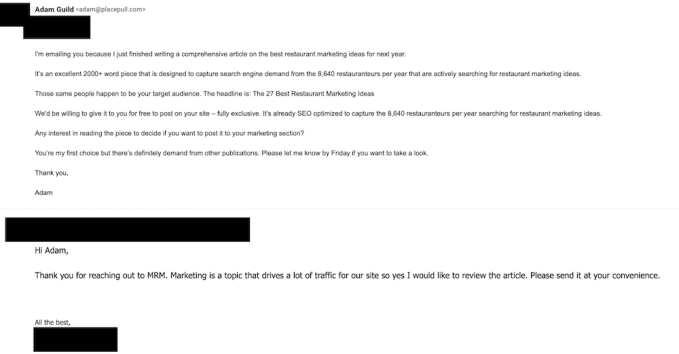
Sure enough, I got a reply within 45 minutes of having sent that email. The editor who was my first choice said she was interested. Now I had to actually write it.
I spent a few hours writing a great article. I was excited because I knew that if I got published and the piece did well for her, I could leverage it to contribute to other publications as well. And I made sure to write it in a way that was SEO-optimized.
SEO optimization came down to having a few occurrences of the primary keyword (“restaurant marketing ideas”) and addressing the intent of a person searching for that keyword. In that case, that meant sharing ideas that they could apply to immediately increase sales in their restaurant. Plus, I included a meta title and meta description for the editor to use that I knew would drive clicks.
The articles themselves also had to be lengthy (2,000+ words). Search engines tend to favor longer content. I suspect this is because it leads to a higher average session duration. I sent her the article and she ended up liking it enough to post it.
Now I had to make sure it performed well for her and drove lots of traffic. I posted it on my LinkedIn and a few restaurant owner Facebook groups. Sure enough, the article took off! It addressed exactly what thousands of people were searching for and drove 2,000 pageviews in its first weekend.
I even got an email from the editor congratulating me on our success and then another informing me that they had pinned the story to their homepage.

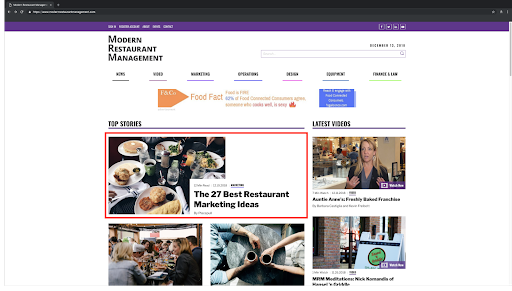
Eventually, the story even ranked in the top three on Google for keyword “restaurant marketing ideas” and to this day has driven them over 20,000 unique visitors and 936 social shares.
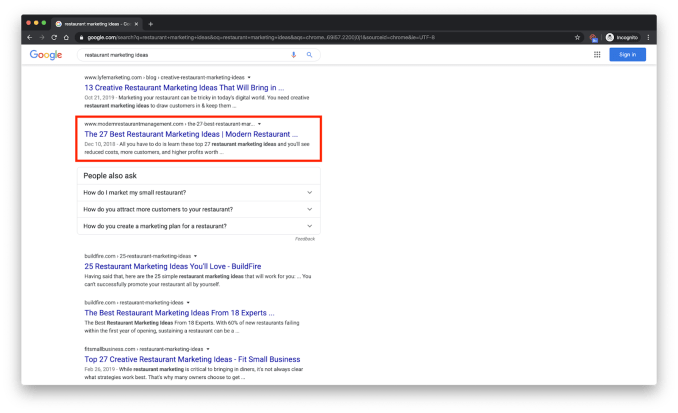
Now, I had leverage I could use with other trade publications and blogs. A case study, if you will.
So I continued contributing stories to MRM Magazine and used our continued success metrics (views + shares) to start pitching other publications as well. I used the same pitch, but this time with more social proof, a success study and a new keyword to create content for with lots of demand and little competition.
Then I got a yes from a second publication. Then a third. Then a fourth. They realized that I was why their competitor was on the rise and had a newfound urgency for more SEO-optimized content. If they didn’t get some themselves, they would get passed in traffic.
Not only was I getting more features, I was getting inbound leads. Potential customers were emailing me saying they loved my article and asking me for help. They were finding our homepage and asking to learn more about our product. Many of those people ended up converting into customers for our software, being worth thousands of dollars each. The customer acquisition cost on each was technically free, because I was just investing my own time and each person seemed more ready to buy on the call because they trusted me going in.
As an outsider building a startup in the space, I also had some unique insights to share that others needed. All good founders do. By seeking to improve the way things work, we uncover secrets that people in the industry find interesting.
For example, I wrote one article with a contrarian insight that drove dozens of inbound leads. It was about discounting. Discounting is common practice in the restaurant industry. But it’s wildly unprofitable and damaging in the vast majority of cases.
I noticed this in finding studies which suggested that discounting actually decreased willingness to pay, frequency, and lowered perception of brand in retail. Then our team validated those studies (to see if they would apply to restaurants) with split tests on our customers’ sites. And the result was shocking.
The majority of the industry was wrong, losing money because of it, and I had an incredible insight to share with them about it. I immediately pitched the editor of one of the most prominent restaurant publications and he was intrigued.
I wrote it and got it published within the week.
The editor loved it because of the response he received from industry insiders about it. We even had one prominent brand contact us because they had millions of dollars at stake with those findings and wanted to learn more. Our insight lead them to trust us and trust our solution. They eventually become a very valuable customer.
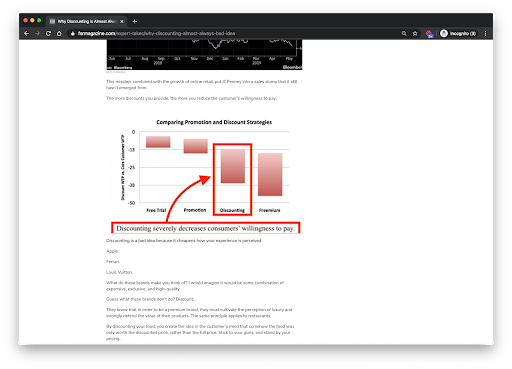
You can find these types of insights too, regardless of your startup or industry. Part of our job as founders is to find stuff to be non-consensus and right about.
One great way to get those findings is by studying more broad contrarian insights (like how customer discounting actually decreases frequency and willingness to pay in retail) and then seeking to validate them in your industry. If it suggests that what most people are doing is actually counterproductive, and you have the research to back it up, it could make people notice you and wonder what other profitable insights you have to share.
Maybe that research will even lead to a breakthrough in your own strategy. I continued contributing content because it was working in building trust, driving sales, and making me more effective in serving the market. At one point, I was contributing over 12 articles per month.
And those articles did well on each trade blog and publication, leading to people who appreciated my insights to email me and ask for help with their restaurant.
I got so good at driving traffic for each publication that I figured it was time that I just drove some for myself and became the publication. I asked each editor if I could start including backlinks in my articles to my own resources and they happily agreed. At that point, I was giving them traffic, great free content and I was proven.
Then I started ranking my own blog’s content for competitive terms like “restaurant promotion ideas” and “restaurant captions.”
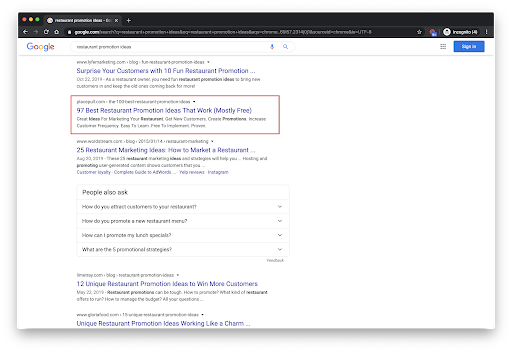
Fast forward six months: my own blog is now the most popular restaurant marketing blog on the Internet. It organically drives more than 37,000 visitors per month and over 740 of those end up opting in to our email list, where we put them in the top of funnel for our own product. Those backlinks are inaccessible to our competitors because they’re unwilling to spend so much time on building trust with each industry resource, editor by editor.
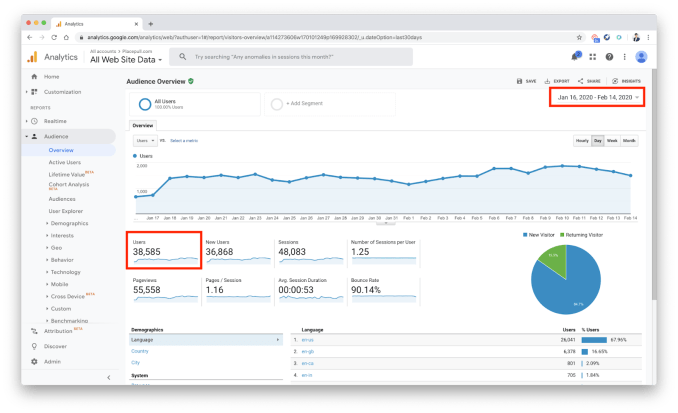
In addition to just traffic, though, this position as an authority in the industry is also helpful in sales calls (when many of the marketing executives and CEOs I’m selling to have seen my content) and leads to industry event organizers asking me to speak at their conferences. A way higher percentage of leads actually reply to my emails now, which I suspect is because they view me as an expert.
Overall, it has become an unfair advantage in selling technology to my market. It took me from being an unknown outsider to a well-known expert in the eyes of the people that decide what to buy.
In most B2B sales, trust that a solution will solve an important problem is why people buy. And trusting the expert whose articles you read for advice is easy.
So, now that you’ve got a great understanding of how this strategy works, are you going to use it in your own business? This strategy is still uncompetitive in most verticals and industry publications are eager for contributors who can drive traffic while producing amazing content.
The one downside I have to mention is that it does take a while — if you’re not committed to succeeding in your industry, or are considering pivoting into another, this strategy is not a good fit because it requires lots of time and patience.
Traffic and trust do not magically cause sales on their own. They definitely help, but there’s additional time that has to be spent further down the funnel on nurturing leads and communicating value effectively.
So, that’s the whole strategy. It’s simple, but it’s not easy. It requires patience, but may just make you (and your company) be seen as leaders in your space while improving your insight and building an unfair advantage of trust.
